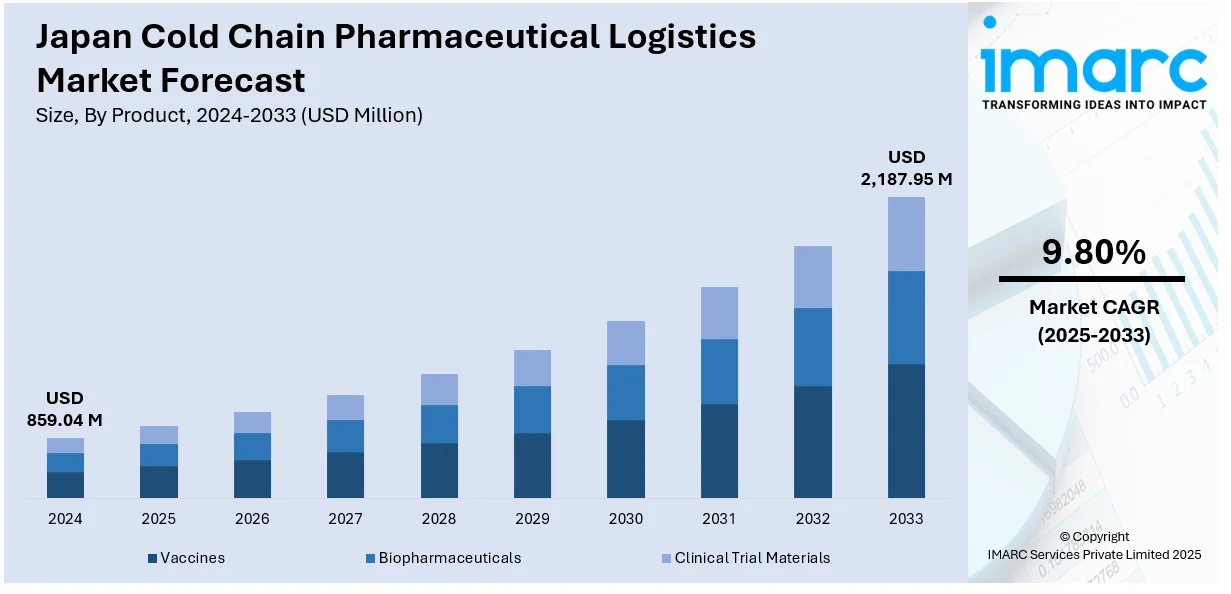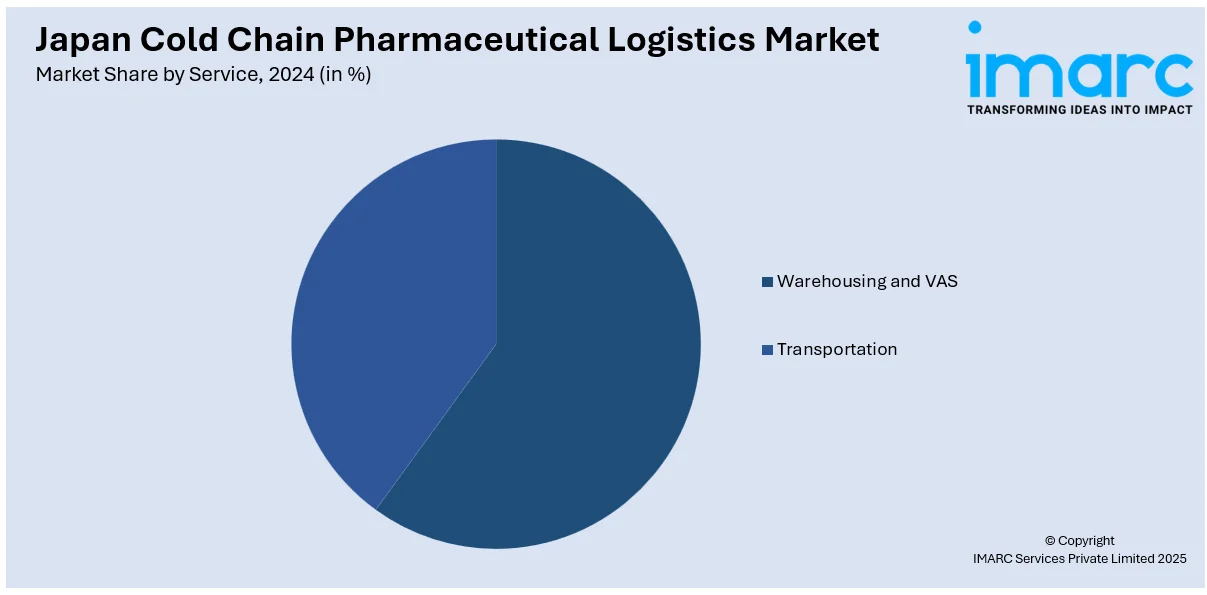
Japan Cold Chain Pharmaceutical Logistics Market Size, Share, Trends and Forecast by Product, Service, and Region, 2025-2033
Japan Cold Chain Pharmaceutical Logistics Market Overview:
The Japan cold chain pharmaceutical logistics market size reached USD 859.04 Million in 2024. Looking forward, IMARC Group expects the market to reach USD 2,187.95 Million by 2033, exhibiting a growth rate (CAGR) of 9.80% during 2025-2033. Pharmaceutical firms, based in Japan, are manufacturing a diverse range of temperature-sensitive medications, including cutting-edge biologics and vaccines, that necessitate dependable cold chain logistics to ensure their effectiveness and safety. Besides this, the rising utilization of the Internet of Things (IoT) is contributing to the expansion of the Japan cold chain pharmaceutical logistics market share.
|
Report Attribute
|
Key Statistics
|
|---|---|
|
Base Year
|
2024 |
|
Forecast Years
|
2025-2033
|
|
Historical Years
|
2019-2024
|
| Market Size in 2024 | USD 859.04 Million |
| Market Forecast in 2033 | USD 2,187.95 Million |
| Market Growth Rate 2025-2033 | 9.80% |
Japan Cold Chain Pharmaceutical Logistics Market Trends:
Increasing demand for pharmaceutical products
Rising demand for pharmaceutical products is positively influencing the market in the country. As the population is aging and healthcare awareness is increasing, more people require medicines, vaccines, and biologics that need strict temperature control. As per the Japanese government authorities, individuals aged 65 and older in Japan represented almost 30% of the population in 2024. Pharmaceutical companies in Japan are producing a wide assortment of temperature-sensitive drugs, including innovative biologics and vaccines, which require reliable cold chain logistics to maintain their efficacy and safety. The increasing volume of these items is leading to higher demand for advanced cold storage facilities, refrigerated transportation, and monitoring systems that ensure proper temperature management throughout the supply chain. Hospitals, pharmacies, and clinics continue to rely heavily on cold chain logistics to receive medicines without degradation. Furthermore, government regulations and quality standards in Japan require stringent compliance in pharmaceutical storage and transport, which is enabling logistics providers to invest in better technology and infrastructure. The rise in export and import of pharmaceutical products is also stimulating the growth of the market, as international shipments demand consistent cold chain management.

Growing utilization of IoT
Rising use of the IoT is impelling the Japan cold chain pharmaceutical logistics market growth. According to the IMARC Group, the Japan IoT market size reached USD 60,477.6 Million in 2024. IoT technology allows real-time monitoring of temperature, humidity, and location of pharmaceutical products during storage and transportation. This ensures that medicines and vaccines remain within the required temperature range, preventing spoilage and maintaining their quality. IoT devices send instant alerts if there is any deviation in conditions, allowing quick corrective actions. This reduces the risk of product loss and ensures compliance with strict regulatory standards in Japan. Additionally, IoT improves inventory management by offering precise information on stock quantities and expiration dates. Logistics companies are using IoT to optimize routes and delivery schedules, reducing delays and costs. The integration of IoT also increases transparency and traceability, building trust among pharmaceutical companies, healthcare providers, and patients. Overall, rising IoT adoption enhances the reliability and effectiveness of cold chain pharmaceutical logistics in Japan, supporting the growing demand for safe and timely delivery of temperature-sensitive medical products.
Japan Cold Chain Pharmaceutical Logistics Market Segmentation:
IMARC Group provides an analysis of the key trends in each segment of the market, along with forecasts at the country and regional levels for 2025-2033. Our report has categorized the market based on product and service.
Product Insights:
- Vaccines
- Biopharmaceuticals
- Clinical Trial Materials
The report has provided a detailed breakup and analysis of the market based on the product. This includes vaccines, biopharmaceuticals, and clinical trial materials.
Service Insights:

- Warehousing and VAS
- Transportation
A detailed breakup and analysis of the market based on the service have also been provided in the report. This includes warehousing and VAS and transportation.
Regional Insights:
- Kanto Region
- Kansai/Kinki Region
- Central/ Chubu Region
- Kyushu-Okinawa Region
- Tohoku Region
- Chugoku Region
- Hokkaido Region
- Shikoku Region
The report has also provided a comprehensive analysis of all the major regional markets, which include Kanto Region, Kansai/Kinki Region, Central/Chubu Region, Kyushu-Okinawa Region, Tohoku Region, Chugoku Region, Hokkaido Region, and Shikoku Region.
Competitive Landscape:
The market research report has also provided a comprehensive analysis of the competitive landscape. Competitive analysis such as market structure, key player positioning, top winning strategies, competitive dashboard, and company evaluation quadrant has been covered in the report. Also, detailed profiles of all major companies have been provided.
Japan Cold Chain Pharmaceutical Logistics Market News:
- In March 2025, Pharma.Aero and the University of Antwerp declared Osaka and Kyoto as the venues for the 2025 Pharma Logistics Masterclass (PLMC), an advanced training initiative for leaders in the Life Sciences and MedTech logistics and supply chain sectors. Kansai Airports was privileged to be the Platinum Sponsor of the PLMC and delighted to host its notable 5th edition, taking place for the first time in Japan. It focused on enhancing the standards of pharmaceutical transportation as an airport, highlighted by the creation of KIX Medica, a temperature-controlled warehouse for pharmaceuticals.
- In March 2024, ELPRO created new subsidiary, ELPRO Japan, officially called ELPRO Corporation, in partnership with Bosch and in coordination with OOSUMI LOGISTICS, to improve customer service and boost business expansion in Japan. The firm announced Ayako Kurauchi as the new managing director for Japan. Having a background in molecular biology and biochemistry, Kurauchi offered years of expertise gained from her previous positions in the pharmaceutical and cold chain logistics sectors.
Japan Cold Chain Pharmaceutical Logistics Market Report Coverage:
| Report Features | Details |
|---|---|
| Base Year of the Analysis | 2024 |
| Historical Period | 2019-2024 |
| Forecast Period | 2025-2033 |
| Units | Million USD |
| Scope of the Report | Exploration of Historical Trends and Market Outlook, Industry Catalysts and Challenges, Segment-Wise Historical and Future Market Assessment:
|
| Products Covered | Vaccines, Biopharmaceuticals, Clinical Trial Materials |
| Services Covered | Warehousing and VAS, Transportation |
| Regions Covered | Kanto Region, Kansai/Kinki Region, Central/Chubu Region, Kyushu-Okinawa Region, Tohoku Region, Chugoku Region, Hokkaido Region, Shikoku Region |
| Customization Scope | 10% Free Customization |
| Post-Sale Analyst Support | 10-12 Weeks |
| Delivery Format | PDF and Excel through Email (We can also provide the editable version of the report in PPT/Word format on special request) |
Key Questions Answered in This Report:
- How has the Japan cold chain pharmaceutical logistics market performed so far and how will it perform in the coming years?
- What is the breakup of the Japan cold chain pharmaceutical logistics market on the basis of product?
- What is the breakup of the Japan cold chain pharmaceutical logistics market on the basis of service?
- What is the breakup of the Japan cold chain pharmaceutical logistics market on the basis of region?
- What are the various stages in the value chain of the Japan cold chain pharmaceutical logistics market?
- What are the key driving factors and challenges in the Japan cold chain pharmaceutical logistics market?
- What is the structure of the Japan cold chain pharmaceutical logistics market and who are the key players?
- What is the degree of competition in the Japan cold chain pharmaceutical logistics market?
Key Benefits for Stakeholders:
- IMARC’s industry report offers a comprehensive quantitative analysis of various market segments, historical and current market trends, market forecasts, and dynamics of the Japan cold chain pharmaceutical logistics market from 2019-2033.
- The research report provides the latest information on the market drivers, challenges, and opportunities in the Japan cold chain pharmaceutical logistics market.
- Porter's five forces analysis assist stakeholders in assessing the impact of new entrants, competitive rivalry, supplier power, buyer power, and the threat of substitution. It helps stakeholders to analyze the level of competition within the Japan cold chain pharmaceutical logistics industry and its attractiveness.
- Competitive landscape allows stakeholders to understand their competitive environment and provides an insight into the current positions of key players in the market.
Need more help?
- Speak to our experienced analysts for insights on the current market scenarios.
- Include additional segments and countries to customize the report as per your requirement.
- Gain an unparalleled competitive advantage in your domain by understanding how to utilize the report and positively impacting your operations and revenue.
- For further assistance, please connect with our analysts.
 Request Customization
Request Customization
 Speak to an Analyst
Speak to an Analyst
 Request Brochure
Request Brochure
 Inquire Before Buying
Inquire Before Buying




.webp)




.webp)












